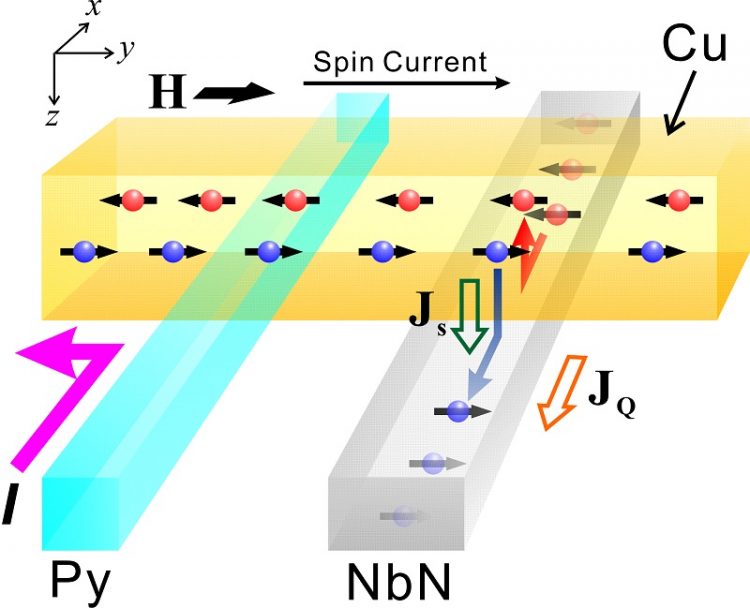Efficient conversion from spin currents to charge currents in a superconductor

Schematic illustration of the device for measuring the SHE in a superconductor Spin injection current (I) between the ferromagnet (Py) and nonmagnet (copper: Cu) generates pure spin currents (JS) in the copper. Pure spin currents flow through the copper into a superconductor (niobium nitride: NbN), and are converted into charge currents (JQ) via the SHE inside the niobium nitride. Copyright : © 2015 Taro Wakamura
A University of Tokyo research group has successfully measured the spin Hall effect in a superconductor for the first time. The spin Hall effect is responsible for the conversion of magnetic flow to current flow and has not been thoroughly examined in superconductors.
Spintronics, or electronics exploiting electron spin, is a research field that has been attracting growing interest in recent decades. It enables us to transmit and manipulate information with lower energy consumption owing to suppression of the Joule heating effect by using pure spin currents, a flow of electrons’ spin angular momentum without any charge flow.
Pure spin currents can be generated and detected via the spin Hall effect (SHE). The amplitude of the SHE depends on the material. A larger SHE indicates more efficient conversion between charge current and spin current, thus many studies have been carried out to discover materials which exhibit a larger SHE.
Whereas normal metals such as platinum or tungsten are regarded as promising candidates for obtaining large SHE, little attention has been paid to SHE in superconductors.
Professor Otani’s research group in the Institute for Solid State Physics has reported the first observation of SHE in a superconductor. The group prepared a device using niobium nitride, and measured the SHE in the superconducting and normal states.
Exploiting the unconventional electronic character of superconductors, the SHE in the superconducting state becomes more than 2,000 times larger than that in the normal state.
This outcome moves forward on realization of spin logic circuits and future development of superconducting spintronics devices.
Associated links
UTokyo Research article
Media Contact
More Information:
http://www.researchsea.comAll latest news from the category: Power and Electrical Engineering
This topic covers issues related to energy generation, conversion, transportation and consumption and how the industry is addressing the challenge of energy efficiency in general.
innovations-report provides in-depth and informative reports and articles on subjects ranging from wind energy, fuel cell technology, solar energy, geothermal energy, petroleum, gas, nuclear engineering, alternative energy and energy efficiency to fusion, hydrogen and superconductor technologies.
Newest articles

High-energy-density aqueous battery based on halogen multi-electron transfer
Traditional non-aqueous lithium-ion batteries have a high energy density, but their safety is compromised due to the flammable organic electrolytes they utilize. Aqueous batteries use water as the solvent for…

First-ever combined heart pump and pig kidney transplant
…gives new hope to patient with terminal illness. Surgeons at NYU Langone Health performed the first-ever combined mechanical heart pump and gene-edited pig kidney transplant surgery in a 54-year-old woman…

Biophysics: Testing how well biomarkers work
LMU researchers have developed a method to determine how reliably target proteins can be labeled using super-resolution fluorescence microscopy. Modern microscopy techniques make it possible to examine the inner workings…





















